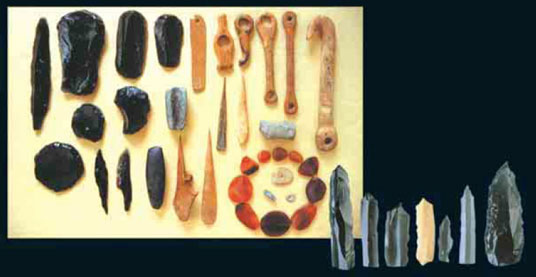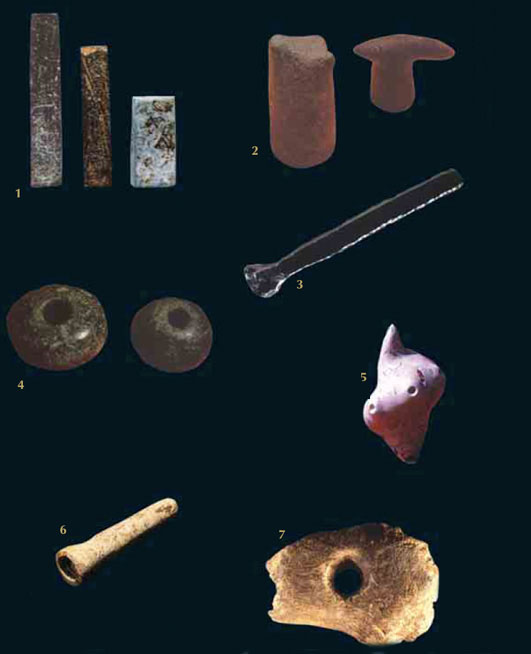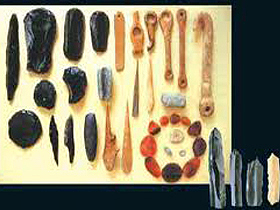The most striking stonework has survived down to the present day in archaeological remains. In order to be able to give stone such a detailed and regular shape, powerful steel tools generally need to be employed. One cannot make fine shapes and designs by abrading or rubbing one stone together with another. Technical infrastructure is essential to accurately cut stones as hard as granite and make patterns on their surface.
Many stone implements remain sharp and bright, reflecting from accurate cutting and shaping. The way evolutionist scientists describe the era they came from as the "Polished Stone Age" is completely unscientific. It is impossible for polish to be preserved over thousands of years. The stones in question shine because they were accurately cut, not because, as is claimed, they were polished. This brightness stems from inside the stone itself.
YOU CAN'T CARVE STONE WITH STONE
Many stone implements remain sharp and bright, reflecting from accurate cutting and shaping. The way evolutionist scientists describe the era they came from as the "Polished Stone Age" is completely unscientific. It is impossible for polish to be preserved over thousands of years. The stones in question shine because they were accurately cut, not because, as is claimed, they were polished. This brightness stems from inside the stone itself.
 |
| Of the bracelets in the above picture, the one on the left is made of marble, and the right one from basalt. They date back to between 8,500 and 9,000 BCE. Evolutionists claim that in that period, only tools made out of stone were used. But basalt and marble are exceptionally hard substances. In order for them to be turned into such rounded links, steel blades and equipment must be used. It is impossible for them to have been cut and shaped without the use of steel tools. If you give anyone a piece of stone and ask him to use it to turn a piece of basalt into a bracelet like that in the picture, what degree of success will they have? Rubbing one stone against another or striking them against one another cannot, of course, produce a bracelet. Moreover, these artifacts show that the people who made them were civilized individuals with aesthetic tastes and an understanding of beauty. |
 |
| The illustrations show hand-made tools of obsidian and bone, hooks and various objects made out of stone. Obviously, one cannot obtain such regular shapes by striking raw material with a stone. Crude blows will merely break the bone and prevent the desired shape from taking form. In the same way, it is clear that sharp lines and pointed tips cannot be possible, even with tools of the very hardest stone, such as granite and basalt. These stones are cut regularly, just like slicing fruit. Their brightness stems not from their being polished, as evolutionists maintain, but from the shaping itself. Those who made these items must have had devices of iron or steel to let them shape these materials in the manner they wished. Slabs of hard stone can be cut so accurately only by using a material even harder, such as steel. |
YOU CAN'T CARVE STONE WITH STONE
The evolutionist historical perspective studies the history of mankind by dividing it up into several periods, just as it does with the supposed course of human evolution itself. Such fictitious concepts as the Stone Age, Bronze Age and Iron Age are an important part of the evolutionist chronology. Since this imaginary picture is presented in schools and in television and newspaper stories, most people accept this imaginary picture without question and imagine that human beings once lived in an era when only primitive stone tools were used and technology was unknown.
Yet when archaeological findings and scientific facts are examined, a very different picture emerges. The traces and remains that have come down to the present—the tools, needles, flute fragments, personal adornments and decorations—show that in cultural and social terms, humans have always lived civilized lives in all periods of history.
Hundreds of thousands of years ago, people lived in houses, engaged in agriculture, exchanged goods, produced textiles, ate, visited relatives, took an interest in music, made paintings, treated the sick, performed their acts of worship and, in short, lived normal lives just as they do today. People who heeded the prophets sent by Allah came to have faith in Him, the One and Only, while others worshipped idols. Believers with faith in Allah abided by the moral values commanded by Him, while others engaged in superstitious practices and deviant rites. At all times in history, just as today, there have been people who believed in the existence of Allah, as well as pagans and atheists.
Of course, throughout history, there have always been those living under simpler, more primitive conditions as well as societies living civilized lives. But this by no means constitutes evidence for the so-called evolution of history, because while one part of the world is launching shuttles into space, people in other lands are still unacquainted with electricity. Yet this does not mean that those who build spacecraft are mentally or physically more advanced—and have progressed further down the supposed evolutionary road and become more culturally evolved—nor that the others are closer to the fictional ape-men. These merely indicate differences in cultures and civilizations.
Yet when archaeological findings and scientific facts are examined, a very different picture emerges. The traces and remains that have come down to the present—the tools, needles, flute fragments, personal adornments and decorations—show that in cultural and social terms, humans have always lived civilized lives in all periods of history.
Hundreds of thousands of years ago, people lived in houses, engaged in agriculture, exchanged goods, produced textiles, ate, visited relatives, took an interest in music, made paintings, treated the sick, performed their acts of worship and, in short, lived normal lives just as they do today. People who heeded the prophets sent by Allah came to have faith in Him, the One and Only, while others worshipped idols. Believers with faith in Allah abided by the moral values commanded by Him, while others engaged in superstitious practices and deviant rites. At all times in history, just as today, there have been people who believed in the existence of Allah, as well as pagans and atheists.
Of course, throughout history, there have always been those living under simpler, more primitive conditions as well as societies living civilized lives. But this by no means constitutes evidence for the so-called evolution of history, because while one part of the world is launching shuttles into space, people in other lands are still unacquainted with electricity. Yet this does not mean that those who build spacecraft are mentally or physically more advanced—and have progressed further down the supposed evolutionary road and become more culturally evolved—nor that the others are closer to the fictional ape-men. These merely indicate differences in cultures and civilizations.
 1 Stone inlays dating back to around 10,000 BCE 2 Pestles dating back to 11,000 BCE 3 An obsidian tool dating back to 10,000 BCE 4 Stone objects dating back to 11,000 BCE 5 Stonework dating back to between 9,000 and 10,000 BCE, with traces of malachite inlay 6 A socketed stone inlay resembling a nail, dating back to around 10,000 BCE 7 A hammer dating back to 10,000 BCE |
| These stone tools date back on average to between 10,000 and 11,000 BCE. Imagine that you wanted to make any one of the objects here by hitting or rubbing one stone with another, in the way evolutionists maintain was done at the time. Try to make regular holes such as those in figure 4. No matter how many times you strike the piece of rock in your hand, you will never be able to make such a perfect hole. To do so, you will need to use a drill made of some harder substance like steel. |


